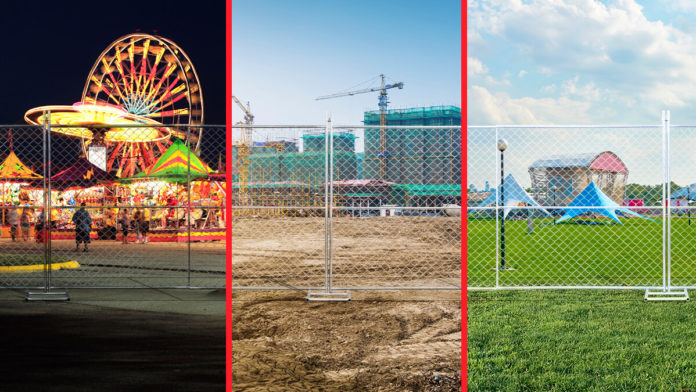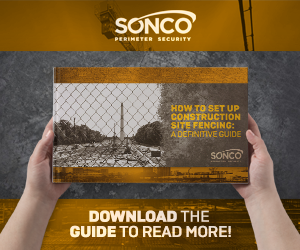When it comes to reliable versatility and cost-efficient perimeter formation, chain-link fencing is an industry mainstay across a range of sectors. Trusted for permanent and temporary applications, this popular temporary fence style is a proven security ally with unmatched utility.
A testament to its dependability, chain-link fencing is widely used across the construction, highway management, events, and equipment leasing industries.
When it’s time to enclose your jobsite, restrict event access, prevent trespassing, or protect assets from thieves and vandals, you need a deep understanding of fence types and features.
Chain-link panels come in a range of materials with varied coatings, wire thicknesses, and diamond-mesh sizes.
This comprehensive guide was created to answer your fence questions, clarify product differences, and supply essential tips for chain-link installation and use.
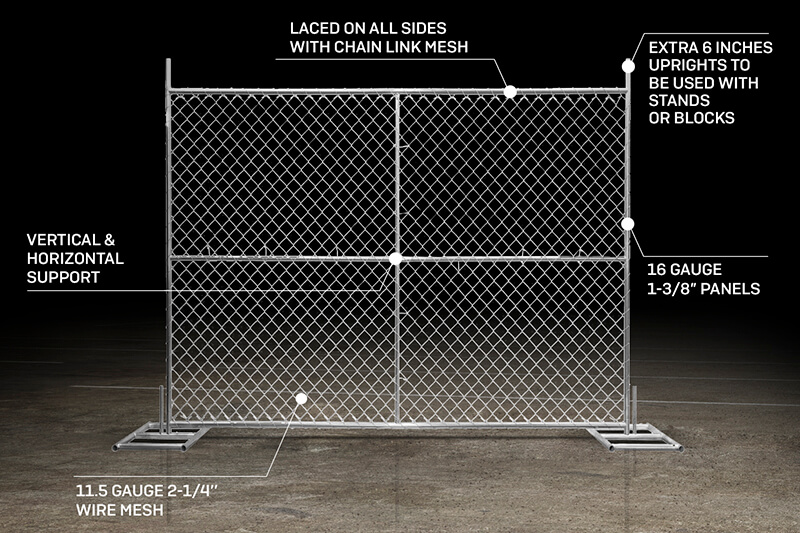
What Is a Chain-Link Fence Panel?
Chain-link fencing (also known as hurricane or chain-wire fencing) is a woven, wire-mesh boundary installed for permanent or temporary use.
Chain-link fences got their start in the United Kingdom in the 1800s, but the inventor’s identity is still unconfirmed. During the 1890s, a Massachusetts-based fence company established the first U.S. patent for a continuous wire-fabric manufacturing process.
The groundbreaking metal-weaving method facilitated rapid fence construction, enabling suppliers to meet high market demands. The fence’s durable, adaptable design quickly made it popular across dozens of applications.
Today’s portable chain-link systems consist of interconnected ‘fence panels’ offered in four sizes, standing at 6 feet tall and available in widths of 8, 10, 12, or 14 feet. This range of widths provides installation flexibility.
How are fence panels built?
A typical temp fence system consists of metal tubes welded at the corners, and an interwoven, diamond-shape mesh stretched between the posts.
- A temporary fence panel is a robust metal frame made from four heavy-duty metal tubes, or “rails.” The rails are welded together at the corner joints.
- Some fence panel frames also include welded vertical or cross-shaped braces, which increase the fence system’s strength and durability.
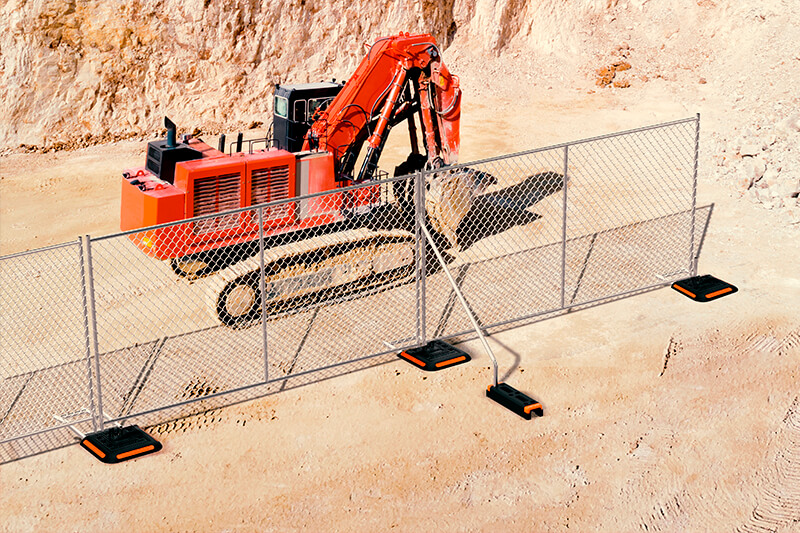
- The fence panel frame is then stretched with chain-link mesh, or “fabric.” Chain-link fabric is constructed from individual wire strands, interwoven into a characteristic diamond-zigzag pattern.
- The mesh fabric attaches to the panel’s top and bottom rails with metal tie wires.
- The fabric is tie-wired to vertical tension bars on the left and right sides. Metal tension bands secure the vertical tension bars to the panel’s vertical rails.
- Multiple fence panels can be connected to create a stable and reliable perimeter.
Benefits of Chain-Link Fences
Chain-link fencing offers many benefits, such as:
- Affordable: premium-quality chain-link is cost-effective when compared to other fencing types, like vinyl or wood. While pricier than plastic mesh, its durability ensures superior long-term value.
- Hassle-free: chain-link panels are very easy to install. Because of their deployment ease, temp fencing is a sought-after and versatile choice for short-term projects, like crowd control at events, and medium-term projects, like construction sites.
Additional chain-wire fence benefits include:
- Adaptability: Chain-link temporary fence systems are fully customizable, from their height, gauge, and coating choices to added accessories. You can add or remove panels for varying perimeter sizes and install pedestrian or vehicle gates for secure access.
- Strength & durability: Chain-link panels are wire-laced for durability, with strength, weather resistance, and corrosion-proof qualities, ensuring they are resilient for long-term use. Use chain-link panels repeatedly.
- Low-maintenance design. Your chain-link fence requires minimal upkeep, saving time, energy, and resources over its lifespan.
- Breathability for compact spaces. When fencing off a small area, total privacy blockage may not be desirable. Chain-link panels offer visibility and breathability that give even tiny venues an “open feel.”
- Modular portability. Fully customizable for your perimeter size and shape, chain-link panels are easy to transport, reposition and relocate. For added transport and storage ease, you can use these space-saving sollage fence racks. Transport up to 30 fence panels per rack, and stack racks for fence rental or facility storage.
- Eco-friendly materials. Temp fence metal is recyclable and is often made from recycled metal, as well — making chain-link a closed-loop, sustainable option for your company’s green initiatives.
- Security & visibility: These simple temp fence systems are proven to be a physical and psychological deterrent for trespassers and thieves. The see-through mesh design also improves visibility at guard gates and screening areas.
To fortify your perimeter further, ask a reputable fence supplier about extra-tall chain-link panels, privacy screen rolls, or chain-link toppers paired with heavy-duty water barriers.
Chain-Link Fence Applications
Chain-link temporary fences are robust, easy to install, and versatile across a wide range of uses. The following list includes popular temp fencing applications for the construction, events, fence rental, schools, and transportation industries.
Construction uses:
- Jobsite security. Wire-mesh fences form a strong, weather-resistant barrier that prevents unauthorized construction zone access.
- Safety. Chain-link fence systems act as barriers, preventing construction debris spillage onto streets, blocking hazardous equipment or areas, and keeping pedestrians and visitors out of danger zones.
- Regulatory compliance & liability control. Building and roadwork crews comply with OSHA standards and construction site safety regulations by installing chain-link panels. These temporary fences also protect contractors from unnecessary legal risk due to inadvertent injuries or jobsite falls.
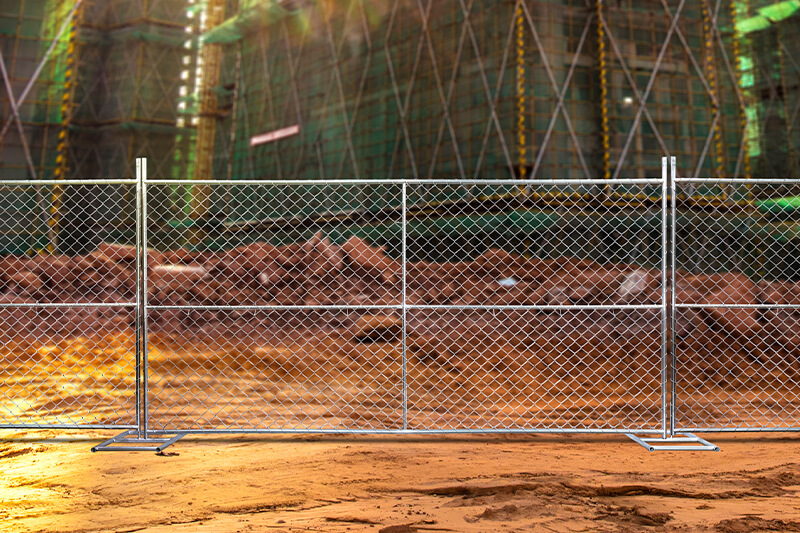
Event uses:
- Crowd management. Chain-link fences help control large, enthusiastic crowds at festivals, concerts, rallies, and sporting events. Acting as a physical and psychological deterrent, these fence panels protect employees, patrons, and performers.
- Venue management. Use temporary metal fencing to demarcate VIP areas, guide foot traffic, protect equipment, and fence off unauthorized areas.
- Adaptable installation. Event producers can tailor chain-link panels to any configuration, accommodating indoor and outdoor event layouts.
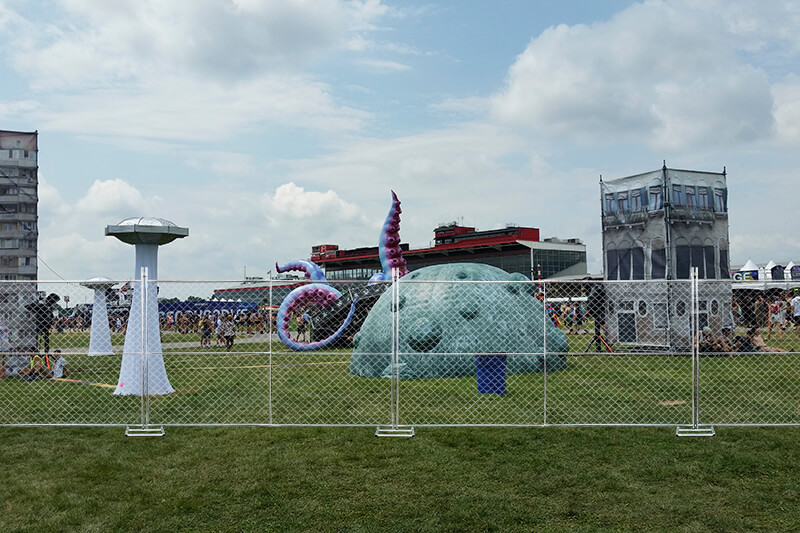
Other uses:
- Equipment leasing companies. Fence rental providers leverage chain-link systems to safeguard their own inventory and meet the diverse needs of rental clients.
- Educational institutions. Trust temporary mesh fencing to secure playgrounds, create sports field perimeters, and provide controlled school access.
- High-profile security. Heavy-duty chain-link fencing forms a perimeter defense for military bases, airports, and power plants. Reinforce fencing with added security features like privacy screens and extra-tall fence panels.
- Transportation hubs: Airports and rental car facilities employ chain-links to delineate parking spaces and runways, control crowd movement, and enhance facility security.
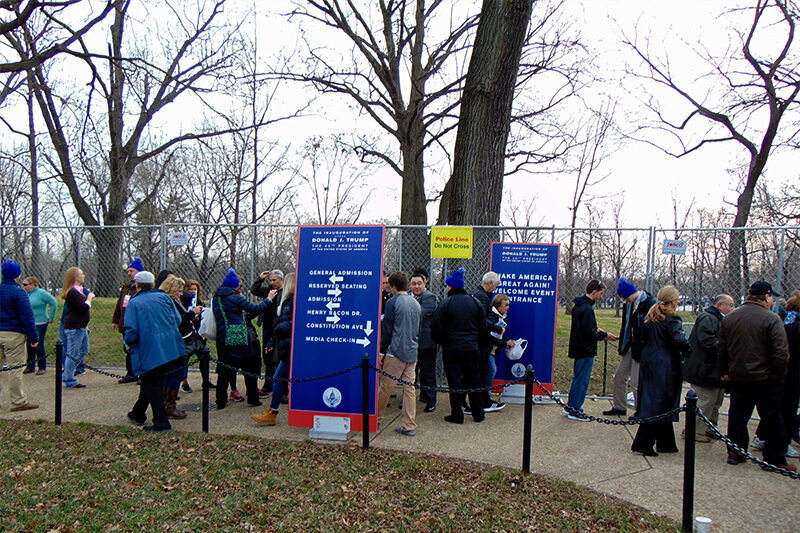
How to Install a Temporary Chain-Link Fence
A well-installed tomporary fence is a stable, reliable boundary that enables successful crowd management, perimeter security, crime deterrence, and more. Before choosing do-it-yourself fence deployment, remember:
- Seasoned fence professionals supply more than experience and knowledge. Using commercial-grade tools and materials, they avoid installation pitfalls and deliver superior results.
- Professional chain-link installation is faster and more convenient than the DIY approach, and installers comply with local and federal safety standards and regulatory guidance.
- Some regions require qualified technicians to install temporary fencing. Check with a temp fence rental company or zoning authority to determine if DIY installation is permitted.
- If you choose to install your own construction fencing or chain-link event fence, research local zoning laws, safety regulations, OSHA fence requirements, and homeowner association guidelines before starting your project. Non-compliance and unsafe fence placement could cost you money, time, and increased legal risk.
DIY Chain-Link Installation: Steps & Tips
To secure your jobsite with safe temporary fence placement, follow the installation steps below. Installing a traditional/permanent chain-link fence? Download the comprehensive fence installation guide from the Chain-Link Manufacturers Institute.
STEP 1: Determine Your Fence Purpose & Choose Materials.
Before selecting fence materials, chain-link coatings, and wire-gauge sizes, decide on the fence’s purpose. This will help determine your fence type, perimeter size, and necessary fence accessories.
STEP 2: Evaluate the Space & Plan for Fence Placement.
The worst fence-installation mistakes generally arise from poor planning. Before transporting fence panels or preparing to install them, analyze your project zone, event venue, or jobsite. Consider these factors:
- Is the ground sturdy and level enough to support chain-link fencing?
- What will the weather be like on installation day? It’s best to install chain-link during temperate weather since rain and wind make fence deployment more challenging. Avoid placing fence panels on slippery surfaces, muddy areas, or rocky terrain.
- Are there power lines or obstacles that might impact installation? Search out a solid, stable foundation for your fence.
STEP 3: Establish a “Fence Foundation” by Positioning Fence Feet.
After deciding on fence placement, lay out fence feet or high-visibility Anchor Fence Bases in preparation for fence-panel deployment.
STEP 4: Install & Connect Chain-Link Panels.
With fence feet in place, deploy temporary chain-link panels by placing them into fence base holes. Continue to set up fence panels until all plastic or metal bases are used. At just 25 to 30 pounds each, fence panels are light and easy to install.
STEP 5: Stabilize the Perimeter with Fence Couplers.
Secure fence panels together using metal fence couplers. Use a drill to install the clamps at a convenient place on the fence frame.
STEP 6: Add Fence Gates, Wheel Kits & Other Accessories.
Take time to add chain-link panel wheels for easy pedestrian and vehicle access.
STEP 7: Install Privacy Screen or Custom Fence Covers.
When applicable, install privacy screens or custom, branded fence coverings.
STEP 8: Access Fence Specification & Inspection Resources.
For more resources and technical support — including fence specification and inspection guides, wind load information, and a list of standard mesh-fabric sizes — visit the Chain-Link Manufacturers Institute.
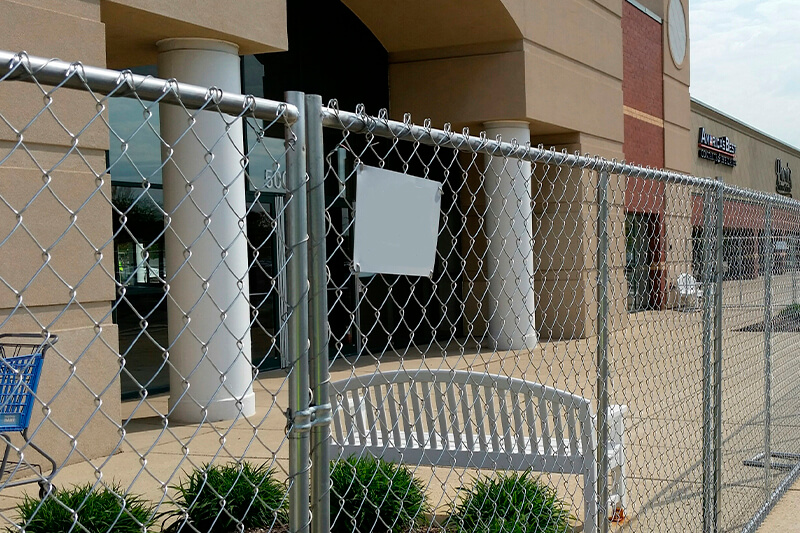
Types of Chain-Link Temp Fence Panels
Chain-link fences are constructed from woven wire mesh and metal posts, but fence materials, styles and coatings vary.
Depending on the manufacturer and material preference, fence fabric may be made from aluminum, steel or galvanized steel. And, while the typical diamond is two inches across, size can vary in commercial, industrial, and residential applications.
Three top chain-link styles include galvanized steel, PVC-coated, and slatted chain-link fencing. Below, we offer the advantages and drawbacks of each so you can make an educated decision.
What is pre-galvanized chain-link?
Pre-galvanized metal fences are built from iron or steel and coated with a modest zinc layer. Upon contact, the zinc bonds with bare metal to form a light, protective barrier that slows the rust and corrosion process.
Is pre-galvanized chain-link corrosion-proof?
While pre-galvanized fences resist corrosion for a time, the thin zinc layer is not protective enough for heavy use.
Eventually, this layer will erode with atmospheric oxygen and acid exposure. Eroded spots are vulnerable to rust, and corrosion spreads when zinc finishes are scratched or damaged.
In addition, pre-galvanized finishes do not cover a fence’s welds, end-cuts or tubing interiors — so these components remain exposed to the elements.
What are the pros and cons of pre-galvanized chain-link fencing?
When it comes to pre-galvanized fences, the commercial and industrial fencing market is filled with unrealized promises. Regrettably, many companies sell cheap, pre-galvanized metal fencing lacking in long-term durability.
Pre-gal fencing is economical, and it will resist corrosion for a time. But in the long run, damage from daily use leads to rust and structural damage — so the fencing delivers a meager return on investment.
When should I use pre-gal temporary fencing?
When budgets are tight, this fence style may be used outdoors — infrequently, in mild weather, for short periods.
Pre-galvanized chain-link is more suitable for light indoor use.
The damage that comes with heavy use (dents or scratches) will leave your perimeter vulnerable to rust. Rust also tends to develop at metal joints, decreasing the fence’s structural integrity.
What is hot-dip galvanized chain-link?
HDG chain-link fences are fabricated from heavy-duty steel and interlocking “chains” woven from thick steel wire.
During galvanization, the fence frame and chain-link fabric are immersed in a hot zinc bath and thoroughly coated for finish protection. As the zinc hardens, it forms a hard layer that safeguards the underlying steel from abuse and outdoor elements.
Is hot-dipped chain-link fencing durable and corrosion-proof?
Yes! The fence’s heavy-duty steel construction and four-layer zinc coating render chain-link panels super-durable and protected from rust.
According to GalvanizeIt.org, a high-performance HDG fence patina slows steel corrosion to 1/30th the rate of uncoated steel (in the same environment).
Boasting a decades-long lifespan, steel HDG fencing can take a beating and retain its structural strength, shiny finish and tell-tale spangle, year after year. According to the American Galvanizers Association, these HDG fence panels offer up to 70 years of rigorous use before succumbing to corrosion.
What are some pros and cons of HDG steel chain-link?
- HDG chain-link is tough and durable with a guaranteed ROI.
- Popular choice for high-security environments due to the proven zinc coating and steel’s unyielding nature.
- Resistant to damage during crowd surges and difficult to breach when properly installed.
- Reliable durability makes it suitable for various applications, from residential use to construction zone safety.
- Ideal for equipment leasing companies as it defies damage in different jobsite conditions or rental environments.
- Forms perimeters for correctional facilities, high-profile security details, utility company substations, military installations, and data processing and storage facilities.
In terms of negatives, hot-dip galvanized chain-link fencing costs more than pre-galvanized or lower-quality boundaries. Still, relatively speaking, it is a moderately priced perimeter option that’s doable for most construction companies.
Other than HDG’s slightly higher cost and its general lack of privacy due to open-weave wires, HDG temp fencing has few drawbacks for most industries.
What is PVC-coated chain-link fencing?
Common in industrial and commercial settings, polyvinyl chloride-coated chain-link is also an aesthetic option for residential containment. Your PVC chain-link fencing is built from heavy-duty metal tubes + steel or aluminum mesh, and all chain-link fabric is wrapped in vinyl.
Vinyl-coated temp fences are a versatile choice for any perimeter. Customize your fence with black, green and brown PVC and enjoy high-performance corrosion resistance along with modern, attractive fence aesthetics. When you need a sleek, modern boundary, PVC-coated chain-link fits the bill and lasts for 15 to 30 years.
Is PVC-coated fencing durable and corrosion-resistant?
Absolutely! PVC coatings stave off rust and corrosion, but they may also be damaged by ultraviolet rays. When you choose high-performance PVC fencing, you’ll enjoy decades of service (depending on climate and coating quality).
What are the pros and cons of PVC-coated chain-link fencing?
- PVC coating provides a barrier against rust, extending the lifespan of the fence.
- Available in multiple colors, PVC-coated chain-link fencing adds personality to residential and commercial properties.
- Suitable for a wide range of applications, including temporary projects, pool or playground spaces, and pet containment fencing.
- PVC-coated chain-link fencing offers increased durability, making it suitable for busy jobsites and industrial applications.
- Requires minimal upkeep compared to other fencing materials, providing convenience for homeowners and facility managers.
- The smooth PVC coating gives the fence a polished look, enhancing the overall aesthetics of the property.
Cons of PVC chain-link coatings include UV-ray damage, sun discoloration or dirt buildup. Even with these downsides, polyvinyl fencing delivers a bright, finished look for homes, facilities and temp fence-rental systems.
What is a slatted chain-link?
When mesh fencing is your best project option — but security and privacy are high priorities — colored fence slats turn open mesh into attractive privacy boundaries. Slat installation is time-consuming, but in the end, these durable inserts are an ideal way to upgrade bare fencing. Create a safer, more polished perimeter with fence slats and chain-link.
What are the benefits of chain-link slatted fencing?
- Allows air to circulate while blocking undesirable views or dissuading potential burglars.
- Though slatted fence styles cost more than open-weave mesh, their heightened privacy and security features dramatically boost fence value and increase ROI.
- Slats can be vertically or horizontally inserted, depending on the look you are going for.
- Replace individual slats when damage occurs. These one-for-one slat changes make fence maintenance affordable and simple.
- Slatted chain-link fencing offers sun and heat protection.
What materials can be used for fence slats?
Durable, removable fence slats come in a variety of materials to suit your project specifications and aesthetic preferences. Options include:
- High-density polyethylene and vinyl slats. Plastic and vinyl slats are durable, budget-friendly, and available in a range of colors to best suit your project. Weather and UV resistant, they require minimal maintenance and are perfect for outdoor applications.
- Aluminum slats. Since these lightweight metal slats are strong and corrosion-resistant, they are a good choice for damp or coastal environments. Choose from a variety of ambience-enriching colors.
- Wood slats. Wood slats can be painted, stained, or left with a natural finish. While wood slats are constructed to resist moisture, they do weather over time and require more maintenance than aluminum, vinyl, or plastic.
Wrap-Up: Embracing Chain-Link Fence Versatility
From standard sizes to custom configurations, chain-link fencing is the ideal perimeter partner.
Versatile, adaptable, and cost-efficient, the wire-woven boundary is an industry favorite for construction, events, equipment leasing, and more. For answers to frequently asked chain-link fence questions, visit the SONCO blog.
Construction crews rely on chain-link fencing as a reusable asset, delivering security and liability protection. For event producers, mesh-wire fencing is a practical way to manage crowds, control access, and designate VIP zones.
Chain-link systems are also a go-to for equipment rental companies, using them to safeguard valuable inventory and secure client perimeters.
For practical, time-tested perimeter solutions customized to your application, contact a SONCO support specialist today. A U.S. industry leader with over 45 years of experience, we provide high-performance temporary fencing to general contractors, construction firms, local and federal governments, highway managers, event venues, schools, and more.
Need to order chain-link temporary fence panels? Save big with bulk discounts and truckload bundles — and don’t forget our stackable sollage racks for space-saving fence transport and storage!


